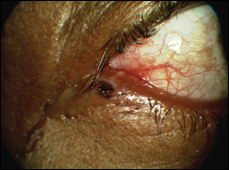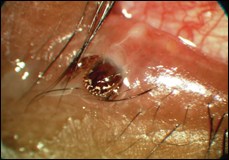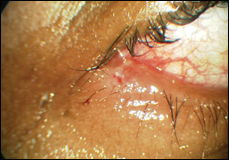Patient presents with swollen, tender eyelid
A 55-year-old African American male presented with a complaint of a swollen, tender right lower eyelid.
The symptoms had been worsening for the past few days and were now accompanied by mucopurulent discharge from the lateral canthus. The patient also reported soreness on the associated side of his face that radiated to his lower jaw and had begun in the last 24 hours. There was no known history of trauma or insult to the affected area.
The patient’s ocular history was remarkable for seasonal allergic conjunctivitis and mild dry eye. He had been successfully treated with topical medications on an episodic basis for these conditions in the past. The only medical history pertinent to the case was a positive PPD test in the remote past.

Images: Neal J
Entering acuities were 20/20 OD and 20/20 OS with spectacle correction. Extraocular movements were full, and confrontation visual field testing was full to finger count in the right and left eyes. The right lower eyelid was erythematous and tender to palpation. Mucopurulent discharge was observed in the inferior fornix, and the eyelashes of the lower lid were matted together.
Upon gross observation there appeared to be a small scab near the lid margin on the temporal aspect of the right lower lid. The swelling of the lower eyelid was significant enough to cause narrowing of the palpebral fissure. An elevated and tender pre-auricular node was detected on the right side. Subsequent palpation of the submandibular lymph nodes revealed that these were enlarged and painful as well. Anterior segment findings were unremarkable in the left eye. Undilated fundus examination was unremarkable in the right and left eyes.
What’s Your Diagnosis?
See answer on the next page.
At this point, differential diagnoses included hordeolum and preseptal cellulitis. Idiopathic orbital inflammation was ruled out due to the presence of mucopurulent discharge and the absence of any other associated findings aside from the swollen lid. The history of allergic conjunctivitis was considered, but the unilateral presentation and lymph node involvement did not fit.
Closer exam, diagnosis
Upon closer examination with the slit lamp all of these were ruled out and a new diagnosis was considered. At this point, a diagnosis of tick infestation of the lower eyelid was readily apparent.
The posterior portion of the offending organism was easily viewable protruding from the site of the bite, while the anterior portion of the organism remained buried in the patient’s flesh. Slit lamp magnification allowed the confirmation that the organism was still viable, as the rear appendages were observed moving freely as the lid was digitally manipulated.

Ticks are part of the family Ixodidae. They are arthropods that attach to the skin of their victims in order to feed by sucking blood from their host. Ticks utilize salivary secretions to assist them in anchoring to their victim. These salivary secretions may also contain anesthetic and anti-hemostatic agents. These agents work in combination to keep the bite site anesthetized and prevent coagulation, allowing the tick to feed unnoticed for variable periods of time. Ticks are commonly known to act as vectors for diseases including but not limited to Lyme, tularemia, Rocky Mountain spotted fever and a group of illnesses classified as Ehrlichia.
Ehrlichiae are intracellular organisms capable of causing infection in both animals and humans. Two varieties of ehrlichioses are known to occur within the U.S. Human monocytic ehrlichiosis (HME) and human granulocytic ehrlichiosis (HGE) are two similar but clinically distinct entities. Coincidentally, the organism that causes HME, Ehrlichia chaffeensis, was first isolated in a recruit at a military installation in Arkansas.
The clinical features of infection with HME and HGE are identical and include generalized malaise, nausea, headache and the possibility of neurological symptoms. Most cases are asymptomatic for a period of days to weeks following the initial infestation, with the patient usually seeking consultation for the generalized systemic manifestations of the disease. The somewhat mild, delayed and generalized onset of the disease is misleading, as HME is known to be potentially fatal.

Traditional management
Management of tick infestation presents the practitioner with a variety of obstacles to overcome in order to successfully treat the patient. It is important to recognize that the presence of an attached arthropod indicates not only an immediate issue at the site of the infestation but the possibility of a systemic infection that may not be clinically significant at the time of presentation.
Treatment modalities for the removal of the organism from the infestation site are relatively straightforward. Experimental data suggests that removal with chemical agents such as petroleum jelly, isopropyl alcohol and hot matches has been ineffective at causing the tick to detach. Apart from being ineffective, these methods may also carry an inherit risk of damaging the ocular surface. Furthermore, such irritants may actually trigger an injection of salivary fluid, which could potentially increase the chances of disease transmission. The best method to remove the tick is by mechanical means. The possibilities include either blunt-tipped tweezers or en bloc excision of the affected area. Following removal, the area should be inspected closely for any residual parts of the arthropod. Any retained material from the organism can lead to a granulomatous reaction or even abscess formation.

This patient’s management
In the case of our patient the entire organism was removed at the slit lamp with a pair of locking tweezers and the application of steady linear force.
The site was cleaned with a cotton swab soaked in a topical antibiotic, as there was a gush of pus and blood from the wound upon removal of the organism. The site was subsequently inspected for residual pieces of the organism, and none were found. The organism itself was examined and determined to be fully intact. Identification of the organism was made using clinical references, and it was determined to be a Lone Star tick, a known vector for Ehrlichiae.
Serologic testing
Current literature does not advocate prophylactic treatment for patients with tick bites unless a variety of conditions are met, and such a discussion exceeds the scope of this article. Serologic testing for ehrlichiosis is available, but there is an incubation period that may yield a false negative early on in the disease state. Antibodies to Ehrlichia are not detected within the first week of infection in up to 85% of patients, according to the CDC; therefore, a negative test does not rule out the diagnosis. Peripheral blood smears may also be utilized to make the diagnosis, but this method only yields a positive result up to 20% of the time, and culture isolation may not be available at many hospitals.
The gold standard for Ehrlichia testing is the indirect immunofluorescence assay. This test requires multiple blood samples to be compared over a period of 2 to 4 weeks. IgM and IgG antibodies are compared quantitatively over this time period with a fourfold increase indicating the presence of the disease (CDC). It is also worthy to note that antibodies to the disease may remain positive for many months after the disease has resolved. In fact, the CDC reported that up to 12% of healthy people may demonstrate elevated antibody titers due a previous infection. This complicated and sometimes difficult-to-obtain regimen of testing makes serological identification and diagnosis of ehrlichiosis a potentially convoluted process.

In this particular case, the patient was exhibiting localized symptoms that warranted treatment in the absence of any serological testing. Serologic and other forms of testing should certainly be considered if the patient remains symptomatic after the initiation of therapy.
Treatment
As mentioned previously, our patient was determined to have been infested with a Lone Star tick. This meant there was a likelihood the patient was at risk for developing ehrlichiosis. Due to the presence of localized symptoms associated with the tick infestation, the decision was made to begin the patient on a course of oral antibiotics. Doxycycline is the treatment of choice and should be administered immediately if ehrlichiosis is suspected. Rifampin and chloramphenicol may also be used but carry a much more significant side effect profile. Our patient was treated with a course of 100 mg of oral doxycycline twice daily for 10 days.
Unfortunately, the patient was lost to follow-up and had to be contacted by phone to discuss his treatment. The patient stated that the soreness in the affected area began to subside on day 2 of the treatment, and he declined to return for evaluation. This is consistent with what is reported in the literature when the infection is successfully treated within the first 5 days. The patient was contacted again by phone on day 7, and he reported that his symptoms had ceased and he again declined to return for evaluation. The patient was seen several months later for routine refractive care, and there was no sign of any residual sequelae from the event.
This case demonstrates that a diagnosis is not always as straightforward as it seems upon gross examination. Careful inspection of the affected ocular structures must be performed to ensure that the proper diagnosis is made. Once the diagnosis is made and a treatment is initiated, the patient must be monitored closely for the development of more dire symptoms. Because these symptoms may take several days to manifest, careful monitoring over time is especially critical. Failure to locate the organism and treat the subsequent infection properly can lead to not only ocular complications but serious systemic morbidities or mortality.
- References:
- Bowes OM, et al. Can J Ophthalmol, 2015;50(3):39-40. doi.org/10.1016/j.jcjo.2014.12.015.
- Carter N, et al. J Neuro-Ophthalmol. 1997;17(1):47-50.
- Centers for Disease Control and Prevention. Ehrlichiosis: Symptoms, diagnosis and treatment. www.cdc.gov/ehrlichiosis/symptoms/. Updated January 21, 2016. Accessed October 18, 2016.
- Keklikçi U, et al. Turk J Pediatr. 2009;51(2):172-173. www.ncbi.nlm.nih.gov/pubmed/19480331.
- Lee M S, et al. Am J Ophthalmol. 2003;135(3):412-413.
- Pendse S, et al. Surv Ophthalmol. 2006;51(3):274-279. doi: 10.1016/j.survophthal.2006.02.004.
- Price KM, et al. Ophthal Plast Reconstr Surg. 2009;25(4):328-330.
- Rai R, et al. Ophthal Plast Reconstr Surg. 2016;32(3).
- For more information:
- John Neal, OD, is a staff optometrist at the North Little Rock VA Hospital in Arkansas. He can be reached at neal.johnm@gmail.com.
- Edited by Leo P. Semes, OD, FAAO, a professor of optometry, University of Alabama at Birmingham and a member of the Primary Care Optometry News Editorial Board. He can be reached at lsemes@uab.edu.
